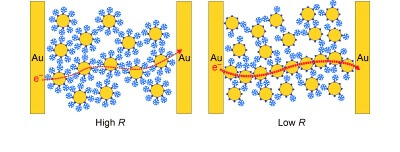A team of researchers from the University of South Wales in Australia has developed a new type of biosensors capable of detecting extremely small amounts of pollutants in liquids in just 40 minutes.

A team of researchers from the University of South Wales in Australia has developed a new type of biosensors capable of detecting extremely small amounts of pollutants in liquids in just 40 minutes.
The new type of biosensors, called "biochemiresistor", has succeeded in meeting the long-standing challenge of developing a sensor that is not only particularly sensitive to the presence of chemical compounds but also has a high response speed. The new sensors have countless possible applications for the detection of drugs, poisons and pesticides in the fields of biomedical or environmental testing.
In an article published in the scientific journal Angewandte Chemie, the researchers describe how they successfully tested the state-of-the-art sensor by detecting tiny amounts of a common veterinary antibiotic found in milk. The journal itself highlighted the article and defined it as a "very important article", when only 5% of all the articles published in it receive this definition.
"The antibiotic substance (Enrofloxacin), which is used in the agricultural industry, is able to move into the food chain," noted Professor Justin Gooding from the School of Chemistry at the University of South Wales in Australia. "Our biosensor was able to detect this substance in raw milk within 40 minutes, at levels as low as one nanogram in a liter of milk. To understand this value, remember that one nanogram is one billionth of a gram and is the mass of a single cell in the body. "While this value in itself is impressive enough, the sensor is a general idea that can be widely applied in many different fields."
A biosensor is a portable analytical device that uses biological molecules to selectively detect one defined compound from a mixture containing many others. Small biosensors are already common today and are used to check the safety of our drinking water, to measure sugar levels in diabetics and in pregnancy test kits.

The new biosensor uses gold-coated magnetic nanoparticles attached to antibodies that are in turn selective for a defined chemical of interest to the tester. The nanoparticles are dispersed inside the sample to be tested and if the required substance is present in it, some of the antibodies attach to it and detach from the nanoparticles.
In the next step, the nanoparticles are collected with the help of a magnet into a thin layer placed between two electrodes where the electrical resistance is measured. The greater the amount of the measured substance, the more antibodies will be detached from the nanoparticles and thus the electrical resistance of the thin layer will decrease.
"This new type of biosensor has a fast response rate since the magnetic nanoparticles in it "go out" and pick up the measured substance, in contrast to the usual approach where you wait until the measured substance finds the sensing areas by itself," explains the researcher. "Our biosensor is also more sensitive than conventional biosensors because once the nanoparticles are dispersed in the sample, the entire sample itself is tested and not just a small part of it."

One response
It is not clear from the article why an electrical conductivity test should take 40 minutes, and at the same time call a quick test.